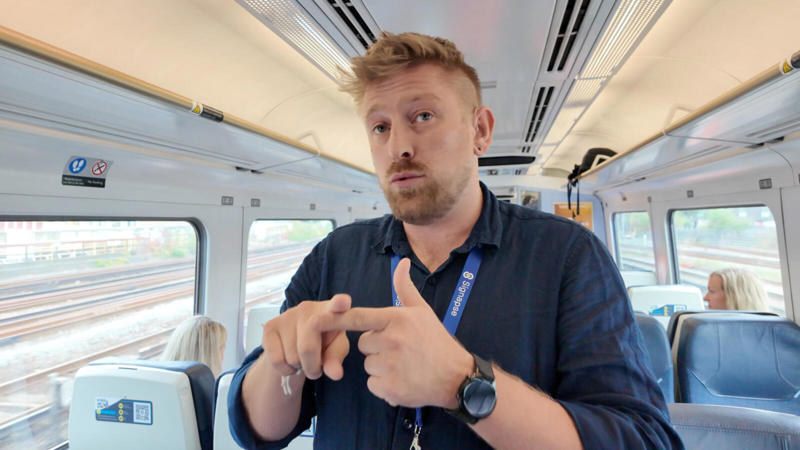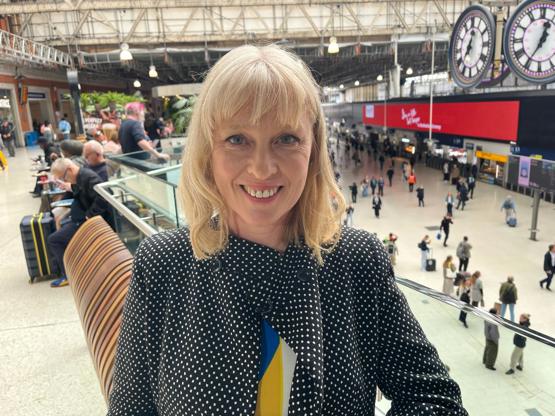South Western Railway is trialling a new system that enables passengers to translate information instantly into British Sign Language, using AI-generated images. Paul Clifton has been finding out how it works.
In this article:
South Western Railway is trialling a new system that enables passengers to translate information instantly into British Sign Language, using AI-generated images. Paul Clifton has been finding out how it works.
In this article:
- South Western Railway introduced QR codes on seats, enabling real-time British Sign Language (BSL) translations for deaf passengers.
- The AI-powered system by Signapse provides photo-realistic sign language translations for announcements, enhancing accessibility.
- The initiative aims to reduce travel anxiety for deaf users and promote equality across public transport networks.

Travelling by train is about to get a bit easier for deaf people.
South Western Railway has launched a new service on its Waterloo to Salisbury and Exeter route.
Passengers scan a QR code on the back of the seat, using their own phone, to have information translated into British Sign Language (BSL).
Deaf actress Sophie Woolley tells RAIL of the challenges of rail travel, while helping to launch the new service at Waterloo.
“I used to feel like a second-class citizen,” she says.
“This makes me feel like I’ve been upgraded to First Class. We feel welcome in a public space. It is valuing us.”
Stickers bearing a code have been attached to seat backs on the Salisbury-based Class 159 trains that operate on the West of England route.
Pointing the camera on a passenger’s mobile phone takes the user straight to a website with real-time travel information.
One click then turns that information into automatically-generated sign language with a remarkably life-like (almost human) translator - identical to the real Marcel Hirshman, a member of the developer’s deaf leadership board.
It has been created by Guildford company Signapse, a technology company which uses the latest AI software to generate instant sign language for public spaces, videos and websites.
“Signapse uses AI to translate into photo-realistic sign language,” explains Marcus Oaten, the company’s deaf impact officer. BSL is his first language.
“It is translation using technology. Any written English information can be translated into British Sign Language, so you’ll be able to access any platform or train announcements.
“We are focusing on public transport initially, because accessibility is crucial to the deaf community.”
Developed during lockdown and formally launched two years ago, the business started with technology academics at the University of Surrey. It secured £2 million in funding in May, with £1.5m coming from investors and £500,000 of public money via Innovate UK.
The ambition is to use AI to translate any English sentence into BSL.
The West of England Line is its first rail use. More will follow.
SWR’s Amy Sullivan explains: “The fleet of trains on that line now have the QR codes for passengers to scan. But we plan to extend to Desiro trains on other routes - to Portsmouth, Weymouth, and Alton.
“Our teams deliver 600 accessibility requests every day across our network. Until now, only 5% of those are for deaf people. This will enable more customers to use our network independently.”
Rachel Benyon, head of translation and data at Signapse, adds: “This is about addressing the barriers deaf people face in public places.
“The AI can create BSL sentences on its own. It learns as it goes along, constantly improving. The language is beautiful, but it needs to be more visible and higher-profile. We need to get information at the same time as everyone else.”
There are 80,000 users of BSL. That’s a small proportion of the one in seven people in the UK who live with some level of hearing loss.
Peter Whale, who heads the rail project for Signapse, says the goal is to transform the rail experience for deaf people.
“It can have a massive impact on our ability to lead normal lives,” he says.
“It will decrease the anxiety of travelling by train. It provides equality for rail users, but by providing the same information that is available to hearing passengers.
“People who took part in the early tests speak of peace of mind and reduction of stress, especially when going somewhere new.”
Airports and buses could follow - and beyond public transport in the UK, Signapse has enormous ambition. It points out that few films or television programmes are signed, and that for some deaf users, sign language is preferable to subtitles on screen.
It is developing a parallel American sign language translator, as there are as many differences between British and American sign language as in the spoken word.
However, the trial on SWR is only funded until March 2025. If it is to continue beyond that, or be extended to other operators, new funding support will be needed.
First person: Sophie Woolley, Actress
“Often, I feel like I am the only deaf person in this space, and deafness can feel invisible,” Sophie Woolley tells RAIL.
The actress has recently been in series three of the Netflix drama Bridgerton, playing Lady Stowell, who communicates in British Sign Language.

“Travel is difficult when something happens that I’m not expecting. For example, if the platform number changes and there’s an announcement from the tannoy, but it’s not shown anywhere. If there’s an announcement that relies on being able to hear clearly, then I might miss it. On the train, or on the platform, or in an emergency.”
Sophie grew up in London able to hear. With a long history of deafness in her family, she lost her hearing in her late teens and now uses a blend of speech and sign language.
“From the age of 18, I would come to Waterloo and stare at the departure board and the faces of other people. At first, we hated mobile phones - they did not help. Now we carry them everywhere. They are life-changing. We sign to each other in video calls.
“I love new technology. AI helps me understand speech in many ways. I use it in a cochlear implant to help me understand people who cannot sign to me. I am so excited about this new travel tool - I can add it to my everyday use.
“When we are the only deaf person in a station, we are no longer alone. Now we can find our own way home.”
Login to continue reading
Or register with RAIL to keep up-to-date with the latest news, insight and opinion.


















Login to comment
Comments
No comments have been made yet.